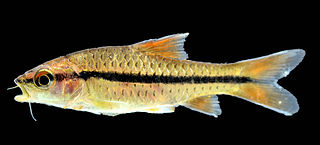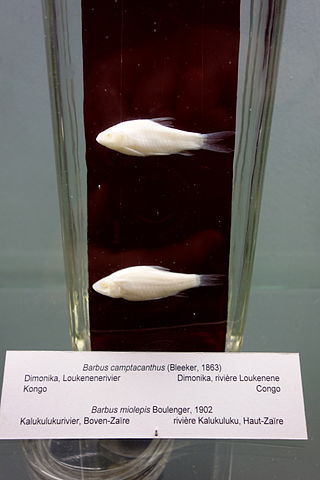Enteromius chiumbeensis is a species of ray-finned fish in the genus Enteromius from the Kasai in the Democratic Republic of the Congo and the Kwango and Kwilu in Angola.
Enteromius kuiluensis is a species of ray-finned fish in the genus Enteromius. It is a freshwater fish that is found in Africa. Enteromius kuiluensis has been found only in the Niari-Kouilou basin in the Republic of Congo.
Enteromius owenae is a species of cyprinid fish in the genus Enteromius which occurs in Lake Bangweulu and the Chambezi River in Zambia.
Enteromius papilio is a species of ray-finned fish in the genus Enteromius.
Enteromius pleurogramma is a species of ray-finned fish in the genus Enteromius. It is endemic to Ethiopia, from the basin of the Blue Nile including Lake Tana.
Enteromius punctitaeniatus is a species of ray-finned fish in the genus Enteromius, which is widespread in West Africa from Senegal to Nigeria.
Enteromius stauchi is a species of ray-finned fish in the genus Enteromius. It may be a synonym of Enteromius rubrostigma and is endemic to the Republic of the Congo.

Enteromius taeniurus is a species of ray-finned fish in the genus Enteromius. It has a body length of about 12 cm and is classified as vulnerable by the IUCN. It is endemic to Cameroon. It is a freshwater tropical fish.
Enteromius tanapelagius is a species of ray-finned fish in the genus Enteromius. It is endemic to Ethiopia.
Enteromius tetrastigma is a species of ray-finned fish in the genus Enteromius which is endemic to Democratic Republic of the Congo.
Enteromius thysi is a species of ray-finned fish in the genus Enteromius which is found in coastal rivers in south-western Cameroon and Bioko.
Enteromius trinotatus is a species of ray-finned fish in the genus Enteromius which is only found in the Democratic Republic of the Congo.
Enteromius trispilopleura is a species of ray-finned fish in the genus Enteromius which is found in Lake Tana in Ethiopia.
The Barotse barb is a species of ray-finned fish in the genus Enteromius from the southern Congo Basin, Zambezi, Okavango, Cunene and Kafue.

Spotscale barb is a species of ray-finned fish in the genus Enteromius which occurs in western central Africa from Cameroon south to Angola.

The blackstripe barb is a species of cyprinid fish in the genus Enteromius which is widely distributed in West Africa where it is harvested for human consumption.
The broadband barb is a species of cyprinid fish in the genus Enteromius. It is found in Lake Malawi and the lower Zambezi, Pungwe River and Buzi River. The broadband barb is exploited for human consumption and for the aquarium trade.

The zigzag barb is a species of cyprinid fish in the genus Enteromius which occurs in the Congo Basin, Okavango River, Kafue River and the upper Zambezi.
The copperstripe barb is a species of cyprinid fish in the genus Enteromius which occurs in central Africa from the Congo Basin to the Zambezi.

Threespot barb is a species of cyprinid fish in the large genus Enteromius. It has a wide distribution in sub-Saharan Africa from the Congo Basin east to the Indian Ocean coast of Tanzania and south to KwaZulu Natal in South Africa. It occurs in shallow water around river inflows or near swampy areas. It is a habitat generalist and also hardy, but it prefers vegetated areas. It feeds on insects and other small animals. It is often caught for use as bait by anglers fishing for tigerfish. It breeds during the summer rainy season when shoals of fertile adults migrate upstream when the rivers are in spate following rain. A single females may produce as many as 8,000 eggs.
This page is based on this
Wikipedia article Text is available under the
CC BY-SA 4.0 license; additional terms may apply.
Images, videos and audio are available under their respective licenses.





